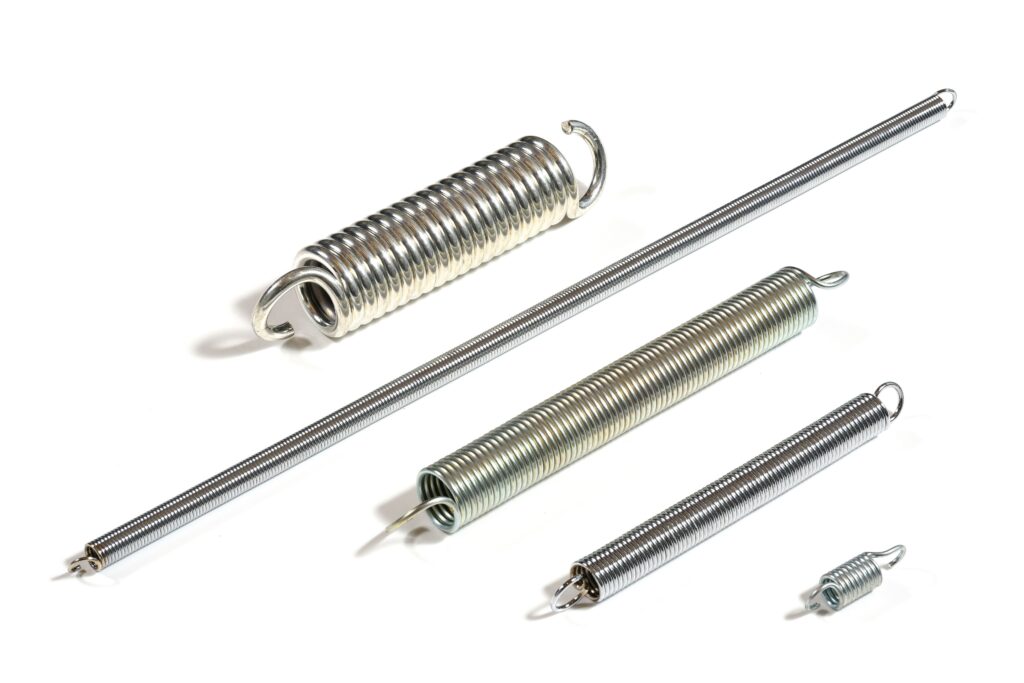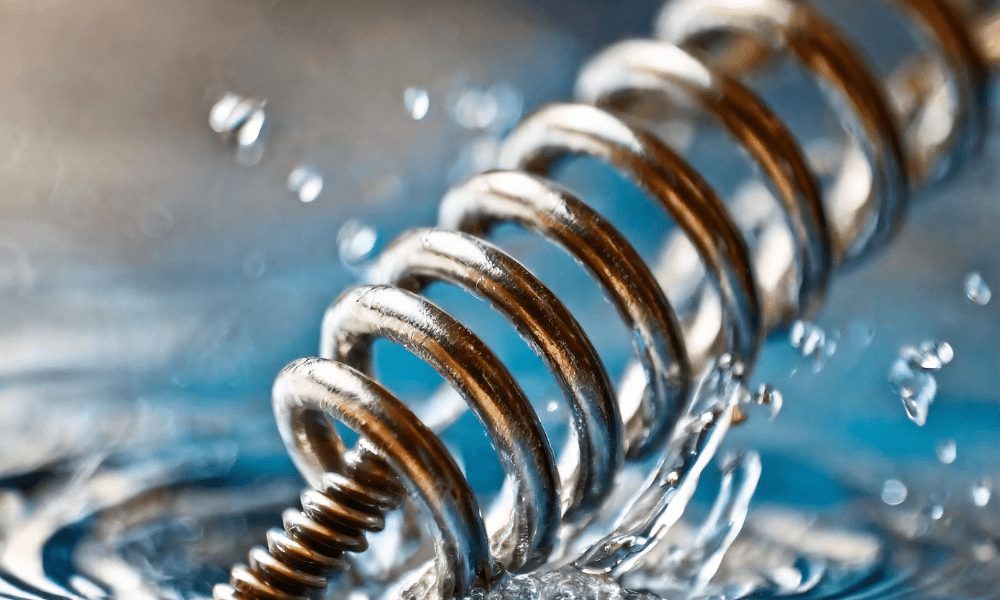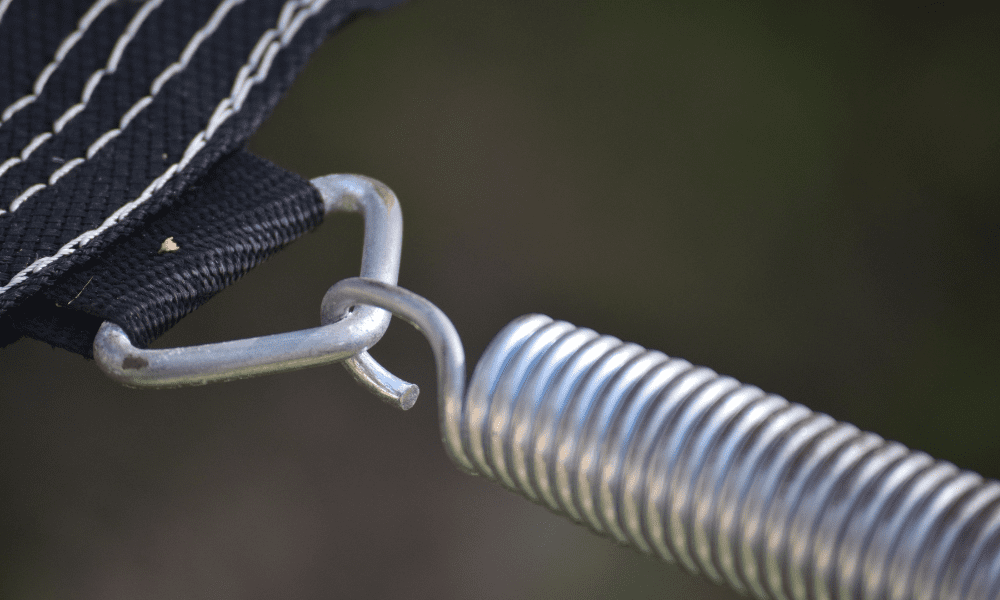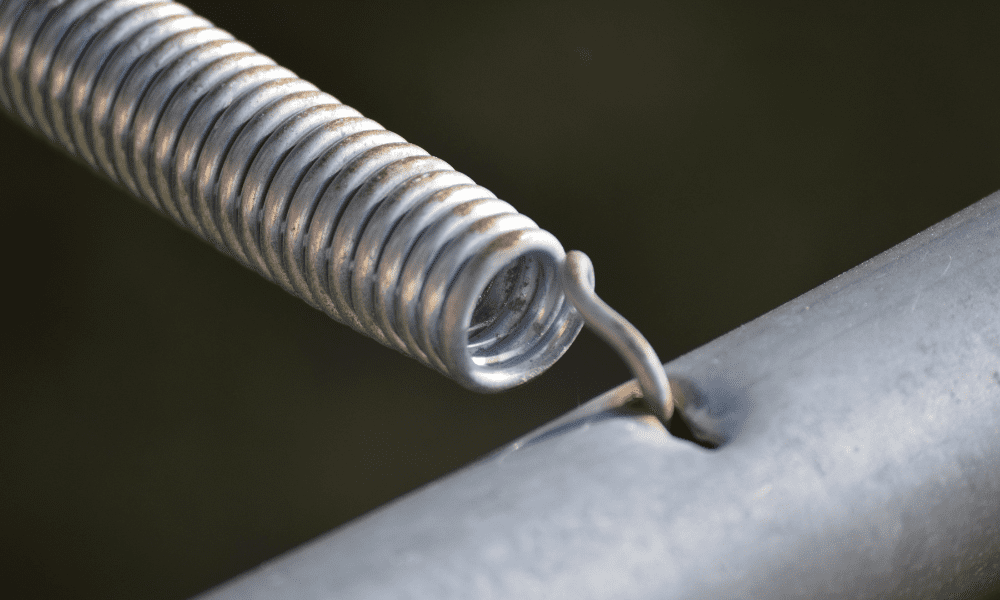
Engineering and mechanical applications require an understanding of the basics of spring design and their parameters. This post investigates two fundamental types: compression springs and tension springs, outlining clear definitions, manufacturing materials, differences in function and real-life applications.
A compression spring stores energy when compressed and a tension spring stores energy when stretched. When the compressive force is removed from a compression spring, energy is released and it expands to its original length. Whereas, when the tensile load is reduced on a tension spring, energy is released and it retracts to its original length.
A compression spring is a mechanical device that absorbs energy and provides a force when compressed. Characterised by its helical design, this type of spring is typically made from various types of wire or metal. The key feature of a compression spring is its ability to resist compressive forces, making it an essential component in a wide range of applications.

The design parameters of a compression spring include the material, coil diameter, wire diameter, free length, spring constant, spring index, solid height, elastic limit, number of coils and end conditions, each tailored to specific needs and functions. There are many types of compression springs such as straight coil springs, convex (barrel) springs, concave springs, conical springs, variable rate springs and banana (sideload) springs.
Compression springs are commonly found in automotive suspensions, valve operations, and electronic devices, where they function by opposing force or absorbing shock. In machinery, they aid in maintaining the force between contacting surfaces and are also used in consumer products like pens and mattresses. They are a staple in manufacturing due to their efficiency in energy storage and release; used widely in both everyday objects and complex machinery.
Compression springs feature uniform coils that have space in between each coil, when in their free-length state (no force applied); when compression is applied, the space between the coils decreases. So, let’s take a look at the materials and load-bearing properties that enable them to reliably provide this resistance against compressive forces.
Compression springs are engineered using a variety of materials, each selected for its unique properties like strength, corrosion resistance, and conductive abilities. Common materials include stainless steel, copper alloys, and high-carbon steel. The build quality of these springs is crucial, involving precise coiling and heat treatment processes to ensure durability and consistent performance. The choice of material and construction technique directly influences the spring's lifespan and effectiveness in different environments.
The load-bearing properties of compression springs are a key aspect of their functionality. These springs are designed to compress under a load and return to their original length when the load is removed, providing a reliable force output. The key parameters affecting their load-bearing capacity include wire diameter, coil count, and spring diameter, as well as buckling considerations. Properly designed compression springs offer excellent resistance to compressive forces, making them suitable for a wide range of applications where control and stability under load are essential.
A tension spring, also known as an extension spring, is designed to operate with a tensile load. As the name suggests, these springs are stretched under a load, storing energy in the process. They are typically made from a variety of materials and feature hooks or loops at their ends for attachment.

The design of a tension spring is focused on the control of the extension rate and the load capacity. Factors like the material, coil diameter, initial tension, and length under load define their functionality. Initial tension refers to the force that keeps the coils springs together before any external force or load is applied. This initial tension must be overcome before the spring starts to elongate. When a tension spring is manufactured, the coils are wound tightly together and the initial tension is set during this process; a tension spring is stronger when coiled to a higher initial tension. This precision in their design is vital for ensuring that they can reliably withstand repeated stretching and return to their original shape, a quality essential for their diverse applications in machinery and devices.
Tension springs are used in automotive, electronics, and consumer goods, where controlled stretching and retraction are required. These springs are instrumental in mechanisms like garage doors, trampolines, electric guitars, seat belts and agricultural machinery, providing necessary tension and maintaining stability. Their design and material allow for efficient energy absorption and release, making them invaluable in both industrial settings and everyday products.
Tension springs feature uniform coils that are wound tightly together when not under tensile load, these then stretch apart when tensile load is added. Below are the materials and properties that enable them to provide this function.
Tension springs are crafted from high-grade steel or metal alloys, chosen for their strength and flexibility and engineered to endure significant stretching forces. They are noticeably different from compression springs as they often have hooks or secure end loops.
The load-bearing properties of tension springs are a standout feature. These springs are specifically designed to operate under tension, maintaining strength and elasticity even when extended. The load capacity, dependent on factors like wire diameter, coil count, and material strength, is meticulously calibrated to suit the application's requirements. This precision allows tension springs to effectively absorb and store energy, providing the necessary force when extended and reliably returning to their original shape.
The main difference between compression springs and tension springs is that compression springs are designed to keep two components apart from compressive forces, whereas tension springs pull two things together. So, let’s take a closer look at the differences in design, function and load considerations.
Compression and tension springs are significantly different in their design and function. Compression springs are designed to compress under a load and return to their original shape when the load is released, thus they're made to withstand compressive forces. On the other hand, tension springs are built to resist tensile forces; they elongate under a pull force and return to their original length when the force is removed. The end design of these springs also varies: tension springs often have hooks or loops for attachment, while compression springs have an open-coil design.

Compression springs are judged on their ability to bear compressive loads without buckling or losing elasticity. In contrast, the strength of a tension spring is evaluated on its ability to endure stretching forces and its resistance to being pulled apart. The material, wire diameter, and coil dimensions are critical in determining the load capacity and stress distribution in both types of springs. This makes their design a precise science, ensuring optimal performance in their respective functions.
When selecting a spring, the specific requirements of the application need to be carefully considered. Factors like the environment in which the spring will operate, the load it needs to bear, and the type of force (compressive or tensile) it will encounter are key. Understanding the differences between compression and tension springs, and their respective attributes, will guide you towards using the correct style of spring for your needs. Additionally, material properties, such as corrosion resistance and temperature tolerance, should align with the intended use to ensure longevity and optimal performance.
Maintaining springs effectively is essential for ensuring their longevity and reliability. Regular inspections for signs of wear, corrosion, and deformation are vital. It’s important to understand the environmental factors that can affect the spring, such as temperature fluctuations and exposure to chemicals. For compression springs, checking for proper alignment and avoiding over-compression is crucial. Similarly, for tension springs, monitoring for overstretched coils and ensuring proper hook or loop integrity is key.
So, now you understand the differences between compression and tension springs. But do you know which type you need for your application? You can read more about compression springs and tension springs to gain further clarity or simply get in touch with one of our experts to find your answers today. Here at Lesjöfors Springs we design, develop and manufacture custom, heavy-duty springs for various industries including renewables, transport, construction, motorsport, rail, agriculture, energy, mining, robotics and more.
With factories in the UK, Finland and Sweden we are proud to be world leaders, committed to delivering excellence and expertise in manufacturing large-diameter compression, tension and torsion springs.
We are world-leading heavy duty spring manufacturers, delivering the greatest expertise in compression, torsion and tension spring manufacturing.
Delivering impact to every industry, we guarantee spring solutions that will optimise your performance and success.

